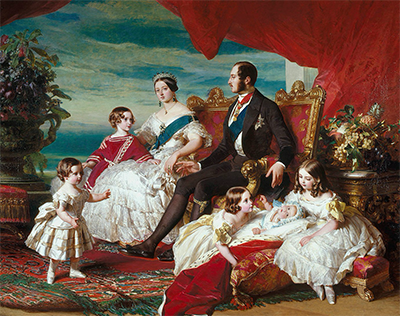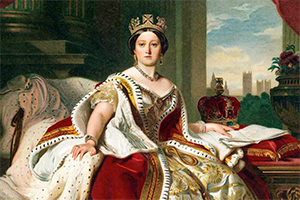Queen Victoria of the United Kingdom
Part 2: Long-reigning Monarch
Like many monarchs before and since, Victoria was focused on succession. First, she had to marry. Of all the suitors that she met in her first few years on the throne, the one she liked the most was Prince Albert of Saxe-Coburg and Gotha, in Germany. The two fell in love and were married in 1840. Victoria started a trend by wearing a white wedding dress–the custom at the time was for the bride to wear a dress of a color other than white, with no set color preferred; the queen also requested that no other woman wear white to her wedding. The royal couple enjoyed many happy years together; got through several intense and passionate arguments; and, even though she was queen and he was prince, functioned effectively as joint monarchs in many ways. Albert it was who introduced the idea of a Christmas tree to the United Kingdom, starting in 1848. Victoria was just 18 when she took the throne. She depended on the Prime Minister, then Lord Melbourne, to help her learn the intricacies of the constitutional monarchy that the United Kingdom had become. Melbourne resigned in 1839, and Sir Robert Peel became Prime Minister. Victoria asserted her authority over what had been previously been parliamentary matters when she refused to let the new Prime Minister choose the royal ladies of the bedchamber. Victoria wanted to keep her own staff, and so she did. 
While Victoria was pregnant with her first child, in 1840, she was the target of an assassination attempt. The assailant fired two shoots at the queen while she and her husband were riding in a carriage. Neither Victoria nor Albert were hurt, and the royal couple gained great sympathy from some in the public who had seen them as unworthy, Victoria because she was a young woman and Albert because he was a foreigner. It was the first of seven assassination attempts on Queen Victoria. She was also for a time the target of a stalker, known as "The Boy Jones." For a period of three years, a lad named Edward Jones broke into Buckingham Palace several times and took indignities such as hiding under the queen's personal sofa and sitting on her throne. He was finally caught and punished. 
Victoria and Albert eventually had nine children. One of the ways in which Britain maintained the peace for much of Victoria's reign was that several of her children married into a number of Europe's royal families and she forbade anyone in her family from going to war:
This was also the time of the Pax Britannica, or "British Peace," a time of about a century, from the end of the Napoleonic Wars to the beginning of World War I, in which, by and large the great powers of Europe did not go to war against one another. Notable exceptions included the Crimean War, which featured the U.K., and the Franco-Prussian War, which did not. In 1845, Ireland suffered through a severe potato blight. More than 1 million Irish people died before the end of the decade, and thousands left the country to avoid what became known as the Great Famine. Victoria, derided as the "Famine Queen," gave £2,000 to Irish famine relief. Victoria herself visited Ireland in 1849. Victoria worked to better relations between her country and France. The two countries had been mortal enemies time and again for the last few centuries. Victoria and Albert visited France's King Louis Philippe I twice, in 1843 and 1845. Victoria thus became the first British or English monarch to pay a state visit to a French monarch since Henry VIII and France's Francis I held court together on the Field of Cloth and Gold in 1520. In between Victoria and Albert's two visits to France, Louis Philippe returned the favor, in 1844 becoming the first French monarch to visit a British monarch. When the Revolutions of 1848 resulted in the ouster of the French king, Louis Philippe went into exile in the U.K. Victoria did not face such a constitutional challenge, although she and Albert, in the face of particularly severe unrest, did leave London at one point in April 1848. The new French monarch, who later became Napoleon III, was Victoria's closest ally during and after the Crimean War, which involved most European powers. Victoria and Louis-Napoleon exchanged state visits as well, Victoria and Albert returning the favor as the guests of honor at a 1,200-guest party at the Palace of Versailles. Next page > A time to remember > Page 1, 2, 3 |
|
Social Studies for Kids
copyright 2002–2026
David White



 Queen Victoria was crowned on June 28, 1838, at Westminster Abbey; records of the time report that more than 400,000 people came to London in connection with the coronation. She was the first U.K. sovereign to live in
Queen Victoria was crowned on June 28, 1838, at Westminster Abbey; records of the time report that more than 400,000 people came to London in connection with the coronation. She was the first U.K. sovereign to live in 
